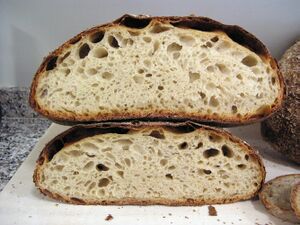Pane casareccio di Genzano (Genzano bread)
IGP Pane casareccio de Genzano is a type of bread obtained using top-quality zero or double zero flour, natural yeast, mineral salt and water, with no chemical or organic additives. The bread is marketed for consumption in the form of round loaves with distinctive marks on the sides, or long loaves, weighing between 0.5kg and 2.5kg. The area of production comprises the whole territory of the commune of Genzano.

The origin of Genzano "homemade" bread is linked to the typical country tradition of the area of production. Each family made its own bread, which was baked in wood-fired ovens known as soccie. Bread-baking day was a day of merry-making throughout the area. Genzano bread was already esteemed last century for its special features, including its fragrant flavour and aroma, which it conserves for seven or eight days. Genzano "homemade" bread is obtained from a dough of natural yeast with zero or double-zero flour, water and salt. By tradition, production is based on what is essentially a three-stage process:
(a) preparation of the dough, using natural yeast renewed on a daily basis in order to obtain characteristic shapes known as bighe;
(b) rising of the dough, which takes place in wooden containers and requires careful supervision by the baker;
(c) baking, to produce a characteristic bread with a crust about 3 mm thick and a soft inner part (crumb) containing lots of bubbles.
The characteristics of the product are dependent on environmental conditions and, more directly, on the human factor. The natural environment has favourable effects on the preparation of the yeast, the rising of the dough and the baking of the bread. In addition, bakers use typical local equipment and follow traditional procedures handed down from generation to generation. The product has become established over the years and is now specifically requested by consumers. This is because its geographical provenance provides a guarantee as to its distinctive characteristics.
"Pane casareccio di Genzano" was already very well known in the 19th century, but since the 1940s it has acquired an enormous reputation in Rome, where it is taken at night and sold in the local bakeries the next day. Efforts to make a bread with the same characteristics have proved unsuccessful, confirming the close link between the product and the water and air of the area where it is made.
Reference: The European Commission